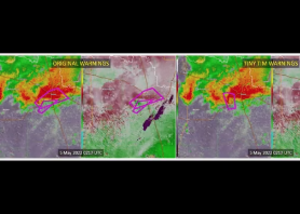New Threats-in-Motion tackles erratic storms

On May 4, 2022, a destructive long-track supercell thunderstorm was moving northeast near Lockett, Texas, while NOAA National Weather Service Meteorologist Vivek Mahale was on duty. The tornado then took a dramatic left turn into the town, and its motion changed to the north and then to the northwest.
With current software, the forecaster draws a warning polygon that is stationary and constrained to its original area; it can only be reduced in size, not expanded. If the storm abruptly changes direction or stalls, a forecaster must issue a new warning to alert the public in the path. During this event, seven separate tornado warnings were issued over roughly the same area to capture this erratic movement.
Mahale had the unique opportunity to rework the same storm using archived data and the experimental Threats in Motion (TiM) software being developed by researchers at the NOAA Global Systems Laboratory and the Mesoscale and Microscale Meteorology Laboratory (MDL). TiM allows forecasters to create hazardous weather warning polygons they can adjust and continuously move with the storm. The same warning remains with the hazard until canceled or expired (the polygon follows the hazard). TiM results in less workload for the forecaster, better comprehension of warning updates, and improved lead times for communities downstream of the threat.
“Using TiM, I could continuously update the tornado warning and the motion vector of the storm as the tornado turned to the left,” said Mahale. “The advantage of Tiny TIM was my ability to continuously reorient the warning polygon as the tornado deviated to the left.”
NWS forecasters have been testing TiM for several years. Several of these new tools will be incorporated into the operational version of Hazard Services, also developed by GSL.
Video caption: Caption: Side-by-side comparison of the new Tiny Threats in Motion (TiM) warnings versus the legacy warning software. Using TiM, the forecaster could continuously update the tornado warning and the motion vector of the storm as the tornado turned to the left, Video courtesy of Greg Stumpf (Meteorological Development Laboratory and Cooperative Institute for Research in the Atmosphere).
